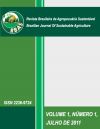SPATIAL VARIABILITY OF VEGETATION AND ANIMAL PRODUCTION IN MONOSPECIFIC GRASSLAND: A PROPOSED CONCEPTUAL MODEL
DOI:
https://doi.org/10.21206/rbas.v1i1.22Abstract
This work was developed to present a conceptual model that considers the spatial variability of vegetation in monospecific pasture as defining characteristic of primary and secondary production in the pastoral environment. According to model, environmental conditions influence the spatial variability of vegetation in pasture. Other factors of heterogeneity are also present in pasture, such as the selective grazing, feces and urine deposition and trampling of ruminants. These factors generate in same pasture different morphological groups, which are plants or tillers of same species of forage crop, with distinct morphological and morphogenesis features. The tissue flow of each morphological group is influenced by environmental factors, so that the tillers of each morphological group have distinct morphogenesis (leaf and stem elongations, leaf emergence and leaf lifespan), and this consequently determines their structural characteristics (leaf and stem sizes, tiller density and live leaf number per tiller). The sum of structural characteristics of each morphological group corresponds to horizontal structure or spatial variability of vegetation in pasture, that is sensitive to anthropogenic grassland management and. The horizontal structure changes the microclimate in pasture, which triggers changes in morphogenesis of morphological groups and also influences the feeding behavior of ruminants, which has effects on forage intake and animal performance. Another factor influencing consumption and, consequently, animal performance is nutritional value of forage, which is the result of structure of each morphological group existing in pasture. Moreover, the morphogenesis of each morphological group influence the production potential of forage in pasture and, along with grazing efficiency, determine the stocking rate of pasture. The animal performance, together with the stocking rate, determines the generation of animal product per unit area.Downloads
Download data is not yet available.
Downloads
Published
2011-07-01
How to Cite
Manoel Eduardo Rozalino Santos. (2011). SPATIAL VARIABILITY OF VEGETATION AND ANIMAL PRODUCTION IN MONOSPECIFIC GRASSLAND: A PROPOSED CONCEPTUAL MODEL. Brazilian Journal of Sustainable Agriculture, 1(1). https://doi.org/10.21206/rbas.v1i1.22
Issue
Section
Artigos
License
1. Proposta de Política para Periódicos de Acesso Livre
Autores que publicam nesta revista concordam com os seguintes termos:
Autores mantém os direitos autorais e concedem à revista o direito de primeira publicação, com o trabalho simultaneamente licenciado sob a Licença Creative Commons Attribution que permite o compartilhamento do trabalho com reconhecimento da autoria e publicação inicial nesta revista.












